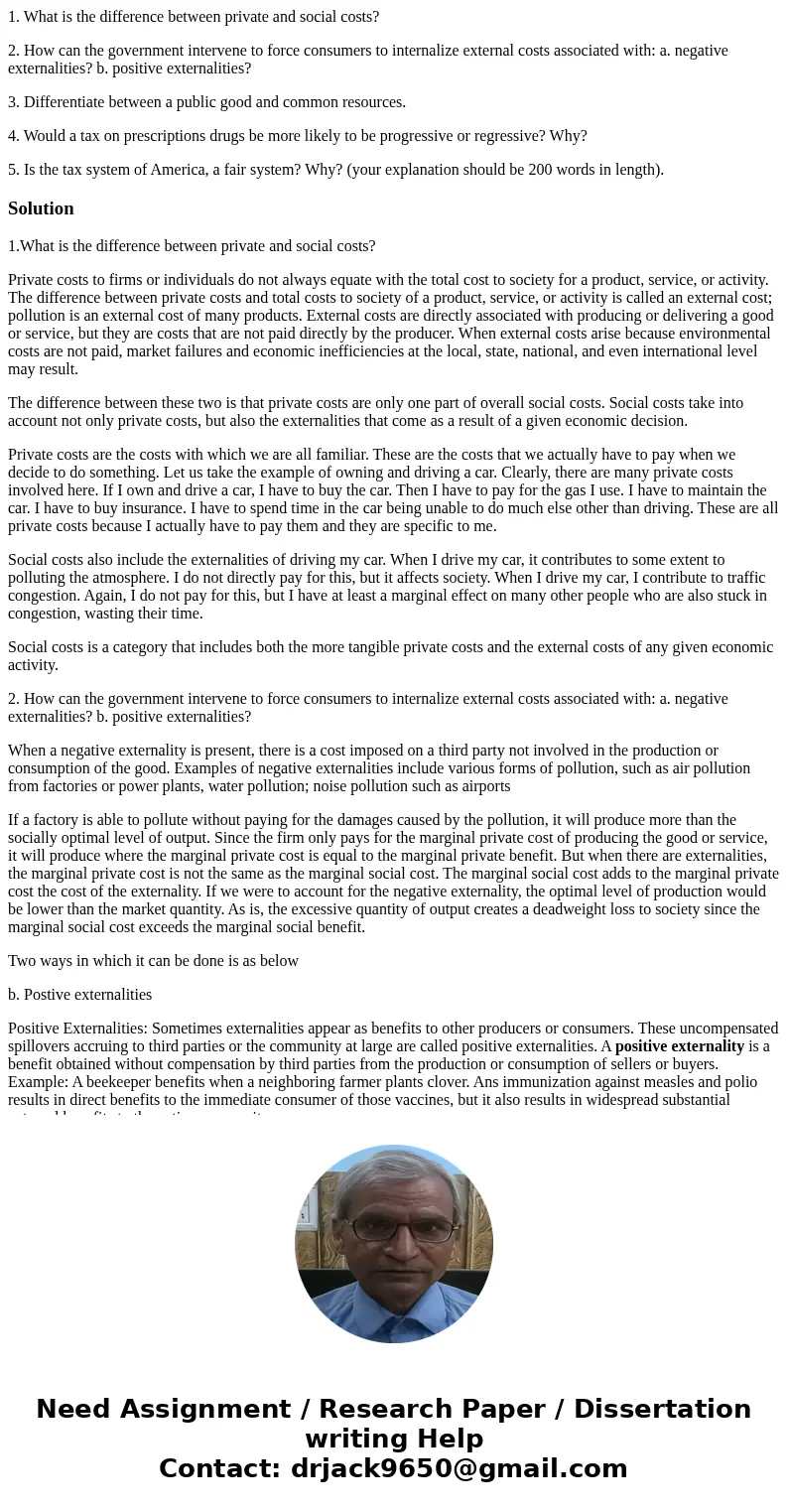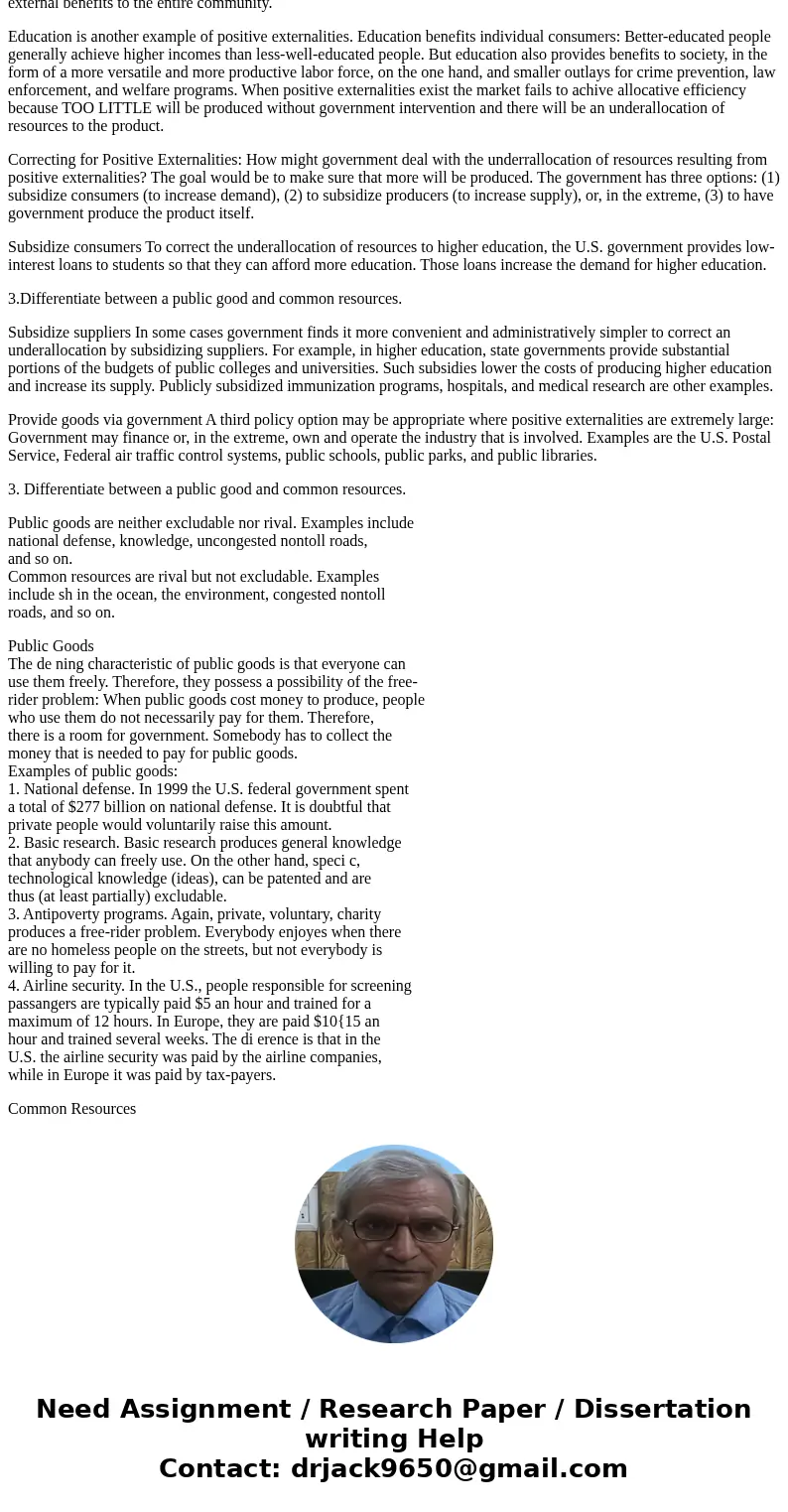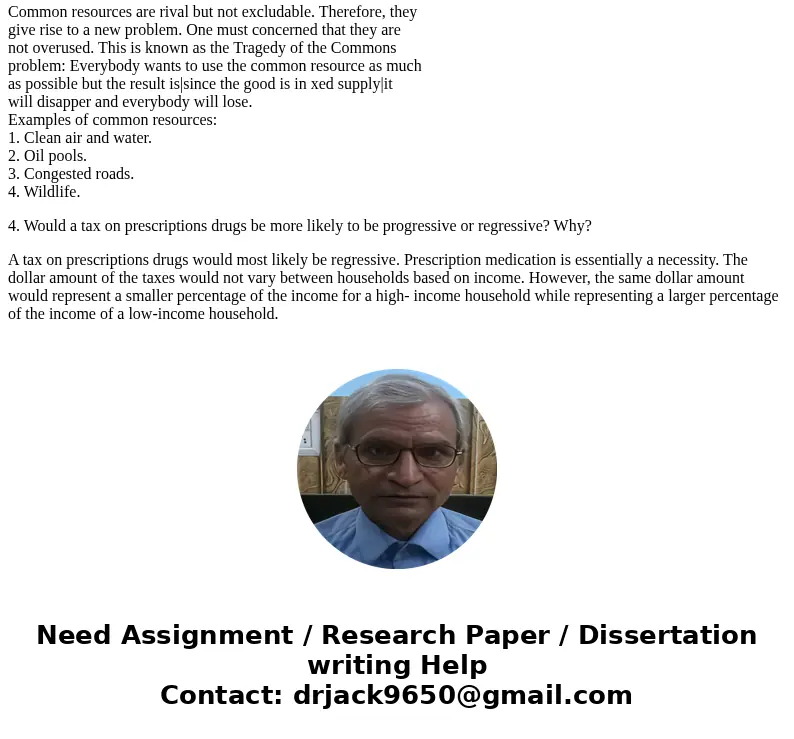1 What is the difference between private and social costs 2
1. What is the difference between private and social costs?
2. How can the government intervene to force consumers to internalize external costs associated with: a. negative externalities? b. positive externalities?
3. Differentiate between a public good and common resources.
4. Would a tax on prescriptions drugs be more likely to be progressive or regressive? Why?
5. Is the tax system of America, a fair system? Why? (your explanation should be 200 words in length).
Solution
1.What is the difference between private and social costs?
Private costs to firms or individuals do not always equate with the total cost to society for a product, service, or activity. The difference between private costs and total costs to society of a product, service, or activity is called an external cost; pollution is an external cost of many products. External costs are directly associated with producing or delivering a good or service, but they are costs that are not paid directly by the producer. When external costs arise because environmental costs are not paid, market failures and economic inefficiencies at the local, state, national, and even international level may result.
The difference between these two is that private costs are only one part of overall social costs. Social costs take into account not only private costs, but also the externalities that come as a result of a given economic decision.
Private costs are the costs with which we are all familiar. These are the costs that we actually have to pay when we decide to do something. Let us take the example of owning and driving a car. Clearly, there are many private costs involved here. If I own and drive a car, I have to buy the car. Then I have to pay for the gas I use. I have to maintain the car. I have to buy insurance. I have to spend time in the car being unable to do much else other than driving. These are all private costs because I actually have to pay them and they are specific to me.
Social costs also include the externalities of driving my car. When I drive my car, it contributes to some extent to polluting the atmosphere. I do not directly pay for this, but it affects society. When I drive my car, I contribute to traffic congestion. Again, I do not pay for this, but I have at least a marginal effect on many other people who are also stuck in congestion, wasting their time.
Social costs is a category that includes both the more tangible private costs and the external costs of any given economic activity.
2. How can the government intervene to force consumers to internalize external costs associated with: a. negative externalities? b. positive externalities?
When a negative externality is present, there is a cost imposed on a third party not involved in the production or consumption of the good. Examples of negative externalities include various forms of pollution, such as air pollution from factories or power plants, water pollution; noise pollution such as airports
If a factory is able to pollute without paying for the damages caused by the pollution, it will produce more than the socially optimal level of output. Since the firm only pays for the marginal private cost of producing the good or service, it will produce where the marginal private cost is equal to the marginal private benefit. But when there are externalities, the marginal private cost is not the same as the marginal social cost. The marginal social cost adds to the marginal private cost the cost of the externality. If we were to account for the negative externality, the optimal level of production would be lower than the market quantity. As is, the excessive quantity of output creates a deadweight loss to society since the marginal social cost exceeds the marginal social benefit.
Two ways in which it can be done is as below
b. Postive externalities
Positive Externalities: Sometimes externalities appear as benefits to other producers or consumers. These uncompensated spillovers accruing to third parties or the community at large are called positive externalities. A positive externality is a benefit obtained without compensation by third parties from the production or consumption of sellers or buyers. Example: A beekeeper benefits when a neighboring farmer plants clover. Ans immunization against measles and polio results in direct benefits to the immediate consumer of those vaccines, but it also results in widespread substantial external benefits to the entire community.
Education is another example of positive externalities. Education benefits individual consumers: Better-educated people generally achieve higher incomes than less-well-educated people. But education also provides benefits to society, in the form of a more versatile and more productive labor force, on the one hand, and smaller outlays for crime prevention, law enforcement, and welfare programs. When positive externalities exist the market fails to achive allocative efficiency because TOO LITTLE will be produced without government intervention and there will be an underallocation of resources to the product.
Correcting for Positive Externalities: How might government deal with the underrallocation of resources resulting from positive externalities? The goal would be to make sure that more will be produced. The government has three options: (1) subsidize consumers (to increase demand), (2) to subsidize producers (to increase supply), or, in the extreme, (3) to have government produce the product itself.
Subsidize consumers To correct the underallocation of resources to higher education, the U.S. government provides low-interest loans to students so that they can afford more education. Those loans increase the demand for higher education.
3.Differentiate between a public good and common resources.
Subsidize suppliers In some cases government finds it more convenient and administratively simpler to correct an underallocation by subsidizing suppliers. For example, in higher education, state governments provide substantial portions of the budgets of public colleges and universities. Such subsidies lower the costs of producing higher education and increase its supply. Publicly subsidized immunization programs, hospitals, and medical research are other examples.
Provide goods via government A third policy option may be appropriate where positive externalities are extremely large: Government may finance or, in the extreme, own and operate the industry that is involved. Examples are the U.S. Postal Service, Federal air traffic control systems, public schools, public parks, and public libraries.
3. Differentiate between a public good and common resources.
Public goods are neither excludable nor rival. Examples include
national defense, knowledge, uncongested nontoll roads,
and so on.
Common resources are rival but not excludable. Examples
include sh in the ocean, the environment, congested nontoll
roads, and so on.
Public Goods
The de ning characteristic of public goods is that everyone can
use them freely. Therefore, they possess a possibility of the free-
rider problem: When public goods cost money to produce, people
who use them do not necessarily pay for them. Therefore,
there is a room for government. Somebody has to collect the
money that is needed to pay for public goods.
Examples of public goods:
1. National defense. In 1999 the U.S. federal government spent
a total of $277 billion on national defense. It is doubtful that
private people would voluntarily raise this amount.
2. Basic research. Basic research produces general knowledge
that anybody can freely use. On the other hand, speci c,
technological knowledge (ideas), can be patented and are
thus (at least partially) excludable.
3. Antipoverty programs. Again, private, voluntary, charity
produces a free-rider problem. Everybody enjoyes when there
are no homeless people on the streets, but not everybody is
willing to pay for it.
4. Airline security. In the U.S., people responsible for screening
passangers are typically paid $5 an hour and trained for a
maximum of 12 hours. In Europe, they are paid $10{15 an
hour and trained several weeks. The di erence is that in the
U.S. the airline security was paid by the airline companies,
while in Europe it was paid by tax-payers.
Common Resources
Common resources are rival but not excludable. Therefore, they
give rise to a new problem. One must concerned that they are
not overused. This is known as the Tragedy of the Commons
problem: Everybody wants to use the common resource as much
as possible but the result is|since the good is in xed supply|it
will disapper and everybody will lose.
Examples of common resources:
1. Clean air and water.
2. Oil pools.
3. Congested roads.
4. Wildlife.
4. Would a tax on prescriptions drugs be more likely to be progressive or regressive? Why?
A tax on prescriptions drugs would most likely be regressive. Prescription medication is essentially a necessity. The dollar amount of the taxes would not vary between households based on income. However, the same dollar amount would represent a smaller percentage of the income for a high- income household while representing a larger percentage of the income of a low-income household.



 Homework Sourse
Homework Sourse